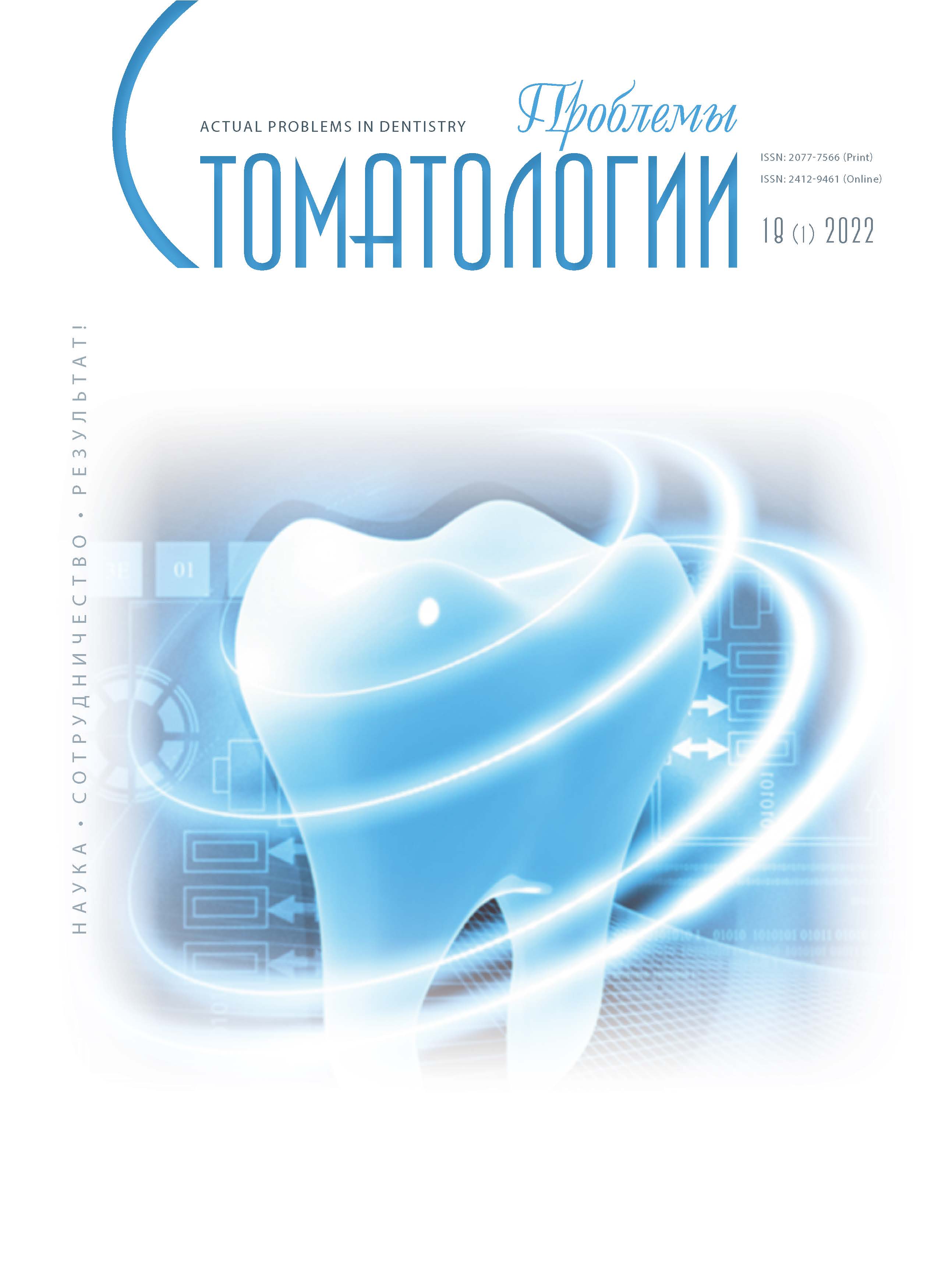Simferopol, Simferopol, Russian Federation
Simferopol, Simferopol, Russian Federation
CSCSTI 76.29
Russian Classification of Professions by Education 31.05.03
Russian Library and Bibliographic Classification 566
Russian Trade and Bibliographic Classification 5773
Oral mucosal cancer is diagnosed worldwide. There are approximately 350,000 patients annually and it accounts for 5% of all malignant neoplasms detected in Europe and the USA. More than 60% of patients with initial treatment in medical institutions are assigned III–IV stage, which requires combined or complex treatment. Under the influence of chemo-radiation therapy, the salivary glands are affected and the physico-chemical properties of saliva change: viscosity, pH, salivation rate, etc. The study involved 89 people from the V.M. Efetov Crimean Republican Oncological Clinical Dispensary with a diagnosis of cancer of the oral mucosa, who, depending on the type of treatment (developed or traditional), were divided into two groups: the main one – using Laetrile in the form of rinses or oral baths for 8–14 days and the control – antitumor treatment according to the protocol (0.06% chlorhexidine solution, ointments for the elements of the lesion – levomycol, vaseline, pharmacy lotion and decoctions of chamomile and sage herbs). A clinical and laboratory evaluation of the salivation function was performed: the volume, salivation rate and relative viscosity of the oral fluid were studied. Oral fluid after irritation of the tongue with a food irritant (0.5% citric acid) was collected in a graduated tube for 5–10 minutes and the volume was determined. The salivation rate and saliva viscosity were determined using an Oswald’s viscometer using the technique of T.L. Redinova (1986). The features of salivation dysfunction in oncopatients receiving chemo-radiation therapy of the oral cavity are a decrease in volume (0.14 ± 0.01 ml) and velocity (0.42 ± 0.018 ml/min), as well as an increase in viscosity (7.42 ± 0.25 p.u.) saliva. The use of Laetrile for 10–14 days from the beginning of the course of chemo-radiation therapy can significantly prevent a decrease in the volume and increase in the viscosity of saliva and minimize the associated decrease in quality of life.
oral mucositis, saliva, treatment, cancer of the oral mucosa, chemo-radiation therapy
1. Redinova T.L., Dmitrakova N.R., Yaspeev A.S. Klinicheskiy metody issledovaniya. Diagnostika v terapevticheskoy stomatologii. Uchebnoe posobie. 2006:144. [T.L. Redinova, N.R. Dmitrakova, A.S. Yaspeev. Clinical research methods. Diagnosis in therapeutic dentistry. Textbook. 2006:144. (In Russ.)]. https://www.labirint.ru/books/111856/
2. Romanenko I.G., Golubinskaya E.P., Zyablitskaya E.Yu., Arakelyan K.A., Makalish T.P. Mucous membrane of the oral mucosa on the model of complications of high-dose radiation and cytostatic cancer therapy the oropharyngeal region // The New Armenian Medical Journal. - 2021;15(1):19-26. https://www.elibrary.ru/item.asp?id=46860362
3. Bykov I.M., Kurzanov A.N. (red.). Klinicheskaya biohimiya rotovoy zhidkosti. Monografiya. Moskva : Izdatel'skiy dom Akademii Estestvoznaniya. 2021:736. [Eds. I.M. Bykov, A.N. Kurzanov. Clinical biochemistry of oral fluid. Monograph. Moscow : Publishing House of the Academy of Natural Sciences. 2021:736. (In Russ.)]. https://www.elibrary.ru/item.asp?id=47913662
4. Sukmanskiy O.I. Biologicheski aktivnye veschestva slyunnyh zhelez. 1991:112. [O.I. Sukmansky. Biologically active substances of the salivary glands. 1991:112. (In Russ.)]. https://books.google.de/books/about/%D0%91%D0%B8%D0%BE%D0%BB%D0%BE%D0%B3%D0%B8%D1%87%D0%B5%D1%81%D0%BA%D0%B8_%D0%B0%D0%BA%D1%82%D0%B8%D0%B2%D0%BD%D1%8B.html?id=0WMYAAAACAAJ&redir_esc=y
5. Avdeeva L.V. Biohimiya. Uchebnik. 2013:768. [L.V. Avdeeva. Biochemistry. Textbook. 2013:768. (In Russ.)]. https://www.labirint.ru/books/296972/
6. Gricuk A.I. Biohimiya rotovoy zhidkosti. Uchebno-metodicheskoe posobie dlya studentov 2 kursa medicinskih VUZov mediko-diagnosticheskogo i lechebnogo fakul'tetov. 2011:40. [A.I. Gritsuk. Biochemistry of the oral fluid. A teaching aid for 2nd year students of medical universities of medical diagnostic and medical faculties. 2011:40. (In Russ.)]. https://elib.gsmu.by/bitstream/handle/GomSMU/2268/%D0%91%D0%B8%D0%BE%D1%85%D0%B8%D0%BC%D0%B8%D1%8F%20%D1%80%D0%BE%D1%82%D0%BE%D0%B2%D0%BE%D0%B9%20%D0%B6%D0%B8%D0%B4%D0%BA%D0%BE%D1%81%D1%82%D0%B8%202.PDF?sequence=1&isAllowed=y
7. Mikaelyan N.P., Komarov O.S. Biohimiya tverdyh tkaney polosti rta v norme i pri patologii. Uchebnoe posobie. 2019:71. [N.P. Mikaelyan, O.S. Komarov. Biochemistry of hard tissues of the oral cavity in normal and pathological conditions. Textbook. 2019:71. (In Russ.)]. https://rsmu.ru/fileadmin/templates/DOC/Faculties/LF/bmb/mp_mikaelyan.pdf
8. Biswas S. Effect of urea on pH, ammonia, amino acids and lactic acid in the human salivary sediment system incubated with varying levels of glucose // Atch. Oral Biol. - 1982;27(9):683-691. doi:https://doi.org/10.1016/0003-9969(82)90193-5.
9. Coogan M.M., Mackeown J.M., Galpin J.S., Fatti L.P. Microbiological impressions of teeth, saliva and dietary fibre can predict caries activity // J. Dent. - 2008;36(11):892-899. doi:https://doi.org/10.1016/j.jdent.2008.07.004.
10. De Farias D.G., Bererra A.C. Salivary antibodies, amylase and protein from children with early childhood caries // Clin. Oral Investig. - 2003;7(3):154-157. doi:https://doi.org/10.1007/s00784-003-0222-7.
11. Mamaev A.M., Kudlaym D.A. Statisticheskie metody v medicine. Prakticheskaya medicina. 2021:136. [A.M. Mamaev, D.A. Kudlaim. Statistical methods in medicine. Practical Medicine. 2021:136. (In Russ.)]. https://www.labirint.ru/books/800429/
12. Truhacheva N.V. Medicinskaya statistika. 2017:324. [N.V. Trukhacheva. Medical statistics. 2017:324. (In Russ.)]. https://www.ozon.ru/product/meditsinskaya-statistika-uchebnoe-posobie-truhacheva-nina-vasilevna-543929143/?sh=QzJVP4v4VA
13. Peterson L., Arvidson I., Lynch E. Fluoride concentrations in saliva and dental plaque in young children after intake of fluoridated milk // Caries Res. - 2002;36:40-43. doi:https://doi.org/10.1159/000057589.
14. Spravochnaya sistema MedElement: Klinicheskie protokoly. Zlokachestvennye novoobrazovaniya polosti rta. [MedElement Help System: Clinical protocols. Malignant neoplasms of the oral cavity. (In Russ.)]. https://diseases.medelement.com/disease/zlokachestvennye-novoobrazovaniya-polosti-rta-2018/16195
15. Glans S. Mediko-biologicheskaya statistika. 1998:462. [S. Glans. Biomedical statistics. 1998:462. (In Russ.)]. http://medstatistic.ru/articles/glantz.pdf
16. Radzhapova M.U., Gulidov I.A., Sevryukov F.E., Mardynskiy Yu.S., Panaseykin Yu.A., Semenov A.V., Ivanov S.A., Kaprin A.D. Himioluchevaya terapiya bol'nyh rakom slizistoy obolochki polosti rta s ispol'zovaniem giperfrakcionirovaniya dozy oblucheniya. Sibirskiy onkologicheskiy zhurnal. 2021;20(2):29-36. [M.U. Radzhapova, I.A. Gulidov, F.E. Sevryukov, Yu.S. Mardynsky, Yu.A. Panaseikin, A.V. Semenov, S.A. Ivanov, A.D. Kaprin. Chemoradiation therapy of patients with cancer of the oral mucosa using hyperfractionation of the radiation dose. Siberian journal of oncology. 2021;20(2):29-36. (In Russ.)]. Doi:https://doi.org/10.21294/1814-4861-2021-20-2-29-36
17. Rebrikova I.V., Polyakov A.P. Spasitel'naya hirurgiya v lechenii pacientov s recidivnym ploskokletochnym rakom polosti rta. Onkologiya. Zhurnal im. P.A. Gercena. 2022;11(1):60-63. [I.V. Rebrikova, A.P. Polyakov. Salvage surgery in the treatment of patients with recurrent oral squamous cell carcinoma. Oncology. Journal them. P.A. Herzen. 2022;11(1):60-63. (In Russ.)]. https://doi.org/10.17116/onkolog20221101160.




















